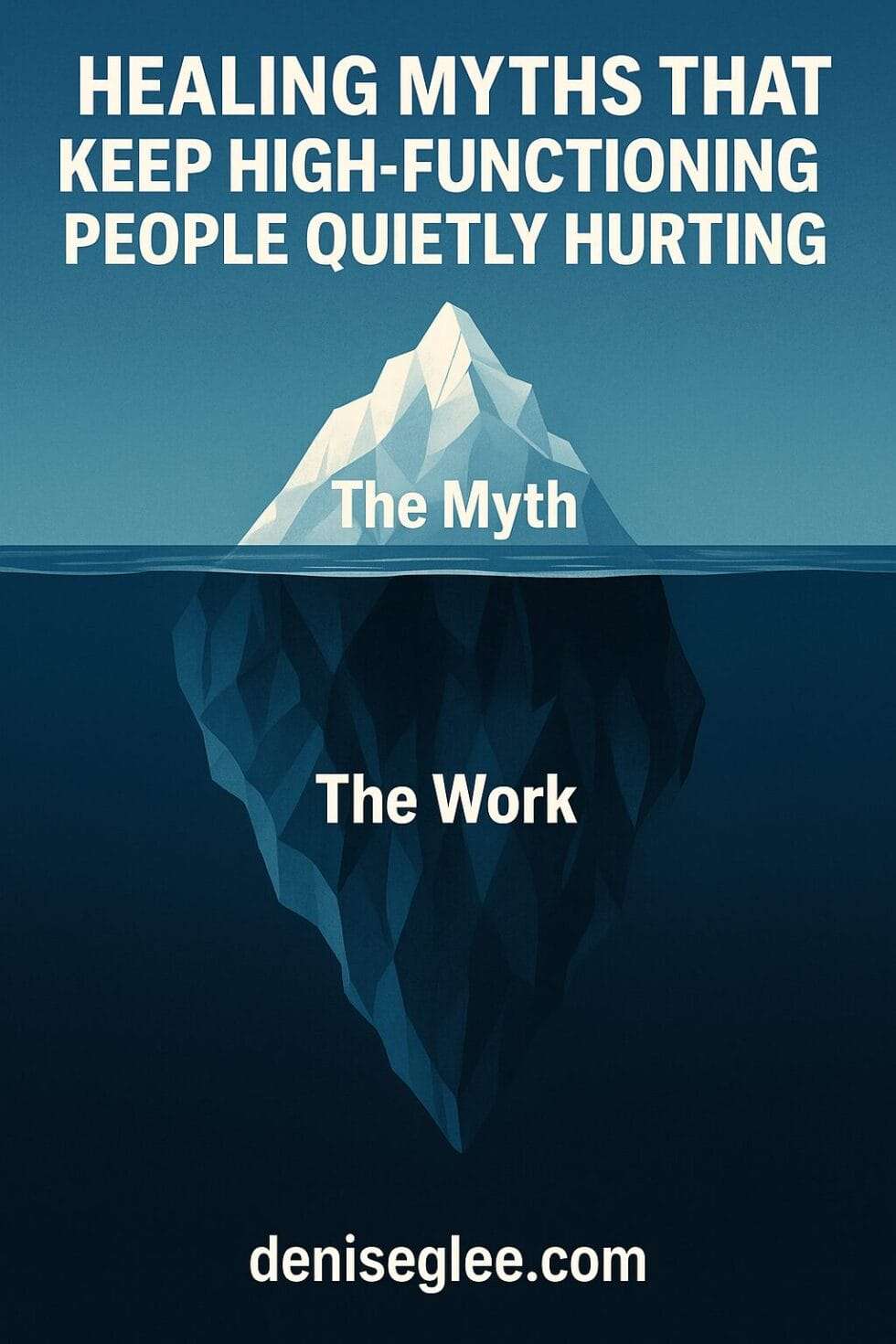
Healing Myths That Keep High-Functioning People Quietly Hurting
- Updated: November 4, 2025
You did the Mel Robbins. The Marie Kondo. The Tony Robbins. Insert any big name, bright stage, or soft-lit podcast that promised you the keys to your freedom.
You journaled your wounds, bought the course, cleaned your closet, drafted the five-year plan. You wrote it all down — the vision board, the new habits, the sticky notes on your mirror.
And yet here you are — still bracing for impact, still carrying the same ache behind your eyes when the house goes quiet.
You’re not dumb. You’re not lazy. You’re not broken.
You’re a high-functioning, driven leader who got sold a pretty idea and a half-truth — that healing is a checklist, a pep talk, a single deep dive that wipes decades clean.
If you’re tired of feeling like you did it “wrong” — when really, you were just missing the fine print — this is for you.
Let’s break the myths. Let’s see what actually heals.
🗺️ The Road Toward Healing
🃏 Why They Lied to You About It Being Easy
Let’s get brutally honest: the healing, self-help, and even parts of the therapy industry don’t sell truth — they sell hope with an expiration date.
They promise ease because struggle doesn’t sell as well.
They promise clarity because confusion is hard to brand.
They promise quick because your brain — like every other human brain — wants quick.
And when you’re already high-functioning? When you’re used to fixing problems, checking the boxes, following the plan?
You’re primed to eat that promise up — and blame yourself when it doesn’t deliver.

They’re in the Business of Worship, Not Healing
They’re not really in the business of healing — they’re in the business of entertainment disguised as transformation.
It’s no different than the televangelist who swears you’ll be saved if you just tithe enough.
The goal isn’t your freedom — it’s your loyalty. They want your worship, your clicks, your confusion — so you’ll keep coming back for the next fix.
Remember Jim Bakker? Jim Humble? Same show, new costume.
People confuse entertainment with actual change. Don’t believe it?
Watch a popular healing guru’s stage show — the gasps, the bright lights, the nodding audience. It’s Maury Povich in yoga pants — calm soundtrack, same cheap drama.
Behind the big reveal or the standing ovation, you don’t see the people after the fact — same wound, same loop, no real closure.
Do you really think the folks on Maury felt healed after the “99.99%” paternity test? Or the shouting match on Judge Judy?
Closure doesn’t come with a spotlight. It comes with real work — and that doesn’t sell as well.
Why the System Wants You Confused
A quick-fix promise keeps you on the hook.
If you heal too fast, there’s no repeat sale.
If you don’t heal, they can always blame your “resistance,” your “block,” your “lack of readiness.”
The worst part? Some of them believe it. Not every coach or therapist is a snake oil merchant — some are just unhealed themselves. Their business model is built on staying your savior instead of teaching you how to stand on your own feet.
The gurus, the brand names, the shiny “trauma-informed” pop-ups? Many learned to package their pain into a program without ever fully walking their own slow road. And the truth is: if they told you how slow, how repeated, how circular real healing is? Most people wouldn’t buy it.
The Industry Incentive: Keep You Spinning
A lot of so-called “healing spaces” are quietly designed to re-traumatize you just enough to keep you signing up for more.
They keep you raw so you need another circle, another course, another “breakthrough.”
They hype urgency because your nervous system spikes when you’re triggered — and that spike makes you impulsive.
They sprinkle spiritual buzzwords to make your doubt feel like your fault.
And Then There’s You
You didn’t fail because you were weak.
You got caught in a system that profits off your pain staying halfway unresolved.
You wanted real — but they fed you shiny.
And if that makes you furious? Good.
Anger is a sign your gut is waking up again.
Keep it awake — because the next step is seeing the myths that live inside you, too.
🪓 10 Common Healing Myths (That Keep You Quietly Hurting)
So if the promise was half-baked — what did they leave out? Here’s the short list of myths that sell like hotcakes but keep high-functioning people bracing for the next hit of hope. But before we go there, you need to see why these myths keep growing back.
🌱 The Soil Beneath the Myths
Killing myths is easy. They’re surface weeds — catchy lines you can snip. But weeds grow back if the soil stays the same.
Every myth feeds on an unspoken idea — the real fertilizer that keeps you spending, circling, or blaming yourself. Let’s dig deeper and see the logic beneath the slogans.

1️⃣ “Time Heals All Wounds”
Underlying assumption: Pain fades on its own — healing is automatic if you wait long enough.
Truth: Time dulls edges, but the body archives unprocessed pain until you feel and rewire it. 67% of adults say childhood trauma still affects them daily (NCTSN). Time numbs — work heals.
2️⃣ “Just Think Positive”
Underlying assumption: Thoughts alone shape reality — bad feelings mean bad thinking.
Truth: Your nervous system shapes your thoughts. Positive thinking without integration is toxic optimism. If your body is stuck in survival, “good vibes” are just paint on a rotten wall. Hope needs a plan, not a Pinterest quote.
3️⃣ “Forgive and You’ll Feel Free”
Underlying assumption: Forgiveness is a switch — the problem is your grudge, not the harm.
Truth: Forgiveness is the result of safety and repaired boundaries — not a shortcut to silence anger. Forced forgiveness bypasses the rage your body needs to reset its guardrails. Real forgiveness grows from true choice and personal responsibility
4️⃣ “Cutting Them Off Solves Everything”
Underlying assumption: Other people are the problem — not your choice.
Truth: Boundaries matter, but if you don’t rewrite why you chose them, you’ll pick their clone next year. You repeat what’s familiar until you see why “familiar” felt like love.
5️⃣ “Breakthrough = Done”
Underlying assumption: Insight equals transformation — knowing better is doing better.
Truth: The “aha” moment feels electric — but your nervous system doesn’t care what you know. It cares what you practice when you’re triggered. (Plenty of people fill out my Life Script, see the mirror, flinch — and run right back to the same loop. A mirror doesn’t heal you. Staying does.) One study found 50% of people with major depression will relapse. Insight without repetition is just a sugar rush.
6️⃣ “If You Still Hurt, You Did It Wrong”
Underlying assumption: Healing means no pain — pain means failure.
Truth: Some grief doesn’t resolve — it integrates. A scar that itches when the weather changes doesn’t mean you failed. That pain is proof you’re alive, moving, and feeling instead of burying.
7️⃣ “Positive Vibes Can Outrun Trauma”
Underlying assumption: Vibes can replace biology — you can ‘high-frequency’ your way out of threat responses.
Truth: High vibes are fine — but your body doesn’t speak Instagram. It speaks safety, repetition, and relationship. No vibe replaces steady re-patterning.
8️⃣ “One Good Retreat Will Fix You”
Underlying assumption: Healing is an event — not a lifestyle.
Truth: A weekend can wake you up — that trip to Peru with the shaman and ayahuasca might open your eyes. But daily life rewires you. Real healing is mundane: choosing, again and again, to respond differently when triggered.
9️⃣ “It’s All About Your Mindset”
Underlying assumption: “Mind over matter.” Mind alone makes or breaks you — biology and community don’t count.
Truth: Mindset matters, but so do your environment, stress load, and support. You can’t “think positive” out of an inflamed nervous system. Healing is wholeness — not just better thinking.
🔟 “Buying the Program = Doing the Work”
Underlying assumption: Knowledge equals change — buying equals doing.
Truth: Buying the book, taking the course — yeah, that feels like progress. But saying “I’ll do it later” is just code for never. Buying is easy; doing is what costs you. Healing only sticks when you practice in real, messy moments: relationships, family, work. No download replaces lived repetition.
Want to keep pulling weeds? Or ready to change the soil?
🗝️ Bottom line:
You didn’t fail. You got handed illusions. Healing is like recovery after major surgery — you don’t hop off the table and run a marathon the next day. It takes time. It takes honesty. It takes rewiring, step by slow step.
Ready? Good. Next, we break down what to do when you’re truly ready to heal.
🪨 What To Do If You’re Ready to Heal
Alright — you see the illusions for what they are. Now what? Here’s the truth: real healing is never a one-time plan. It’s daily choices stacked over time. But it does get clearer when you anchor it in the real world.

🗝️ 1️⃣ Find a Safe Container — Not a Savior
You don’t need another celebrity healer or overpriced hype coach. You need someone — or something — that holds you accountable to your own patterns. Sometimes that’s a trauma-informed coach, sometimes a qualified therapist, sometimes a community that isn’t built on forced positivity. Choose structure and honesty.
🗝️ 2️⃣ Expect Cycles, Not Straight Lines
You will loop back to old pain. You will backslide. That’s normal — not failure. Real healing is seeing the pattern, catching it faster, softening how far it pulls you back each time. Progress is a spiral, not a staircase.
🗝️ 3️⃣ Do It In Your Actual Life
Reading books helps. Listening to podcasts helps. But the real muscle builds when you practice new boundaries at work. When you tell the truth to the person you fear disappointing. When you pause the old script mid-sentence. That’s where change sticks — in the mess, not the notebook.
🗝️ 4️⃣ Track Your Triggers — Without Shame
Start paying attention to where you get hooked. Triggers aren’t proof you’re broken. They’re signs pointing you toward your next layer of healing. Journal them. Say them out loud. Bring them to safe people. Don’t bury them back under ‘I’m fine.’
🗝️ 5️⃣ Be Willing to Sit in the Boring Middle
Healing is rarely glamorous. The middle is quiet, repetitive, unsexy work: regulating your nervous system, noticing the old voice, choosing not to obey it. Again. And again. And again. This is how your story actually changes.
Triggers don’t just show up in conflict—they can sneak in through music, smells, or holidays that remind you who or what you lost.
I explore that seasonal ache in When the Holidays Stir Old Grief You Thought You Buried—why unfinished emotions surface most when the world insists you should feel joyful.
If you’re reading this, you’re already awake enough to want real.
That’s a bigger step than any $5K course could ever give you.
Stay awake. Next, let’s tackle your honest questions — the ones that keep you up at night after the Stripe payment fails you.
❓ FAQs for the Frustrated, Angry, or Just Plain Done

“Why am I still stuck after therapy?”
Because insight alone doesn’t rewire patterns. Many therapists — even well-meaning ones — stop at awareness. Awareness is step one. Integration is step two — and most people skip it. Read how to tell if your healer is just performing if you’re wondering why you didn’t get what you paid for.
“Why didn’t my trauma retreat work?”
A retreat can open your eyes, but it can’t rewire your daily choices back home. It’s a controlled environment. Healing is how you act when your nervous system gets poked in real life. Don’t shame yourself for wanting the quick version — but stop expecting a weekend to fix decades.
“Why do I feel worse after trying to forgive?”
Because forced forgiveness can bypass healthy anger. Anger shows you what needs protecting — and what needs to be rebuilt. If your coach told you to skip that step, that’s not healing. That’s spiritual guilt. Read the red flags of bad coaching here.
“I did the inner work — why am I still triggered?”
Because your body holds score cards your mind can’t erase alone. Triggers are data. They don’t mean you failed — they show you where you still need support and repetition. If you want the real version of this work, read Unqualified Life Coaches: The Hidden Harm of Performative Healing.
“Is it normal to feel broken even after so much healing?”
Yes — because healing doesn’t erase your past. It teaches you to carry it with strength, not let it run you blind. Normal doesn’t mean stuck. It means human.
“Why doesn’t positive thinking help anymore?”
Because your nervous system isn’t a quote board. It needs safety and real boundaries — not just sweet words taped on the fridge. Hope is useless without structure.
“When does healing actually work?”
When you drop the deadline and pick up daily practice. When you stop looking for the next hype high and settle into boring consistency. That’s it. That’s where traction lives.
“Does trauma healing ever really end?”
The pain dulls, the pattern softens, the reflex loses its grip — but life will always offer you edges. You don’t arrive. You build a sturdier core that can meet it differently. Over time, that’s the win.
“I’m tired of self-help. What actually works?”
Safe container. Slow repetition. Brutal honesty. Nervous system work. Real boundaries. A coach or therapist who doesn’t sell illusions — but holds you in the real, messy middle until your patterns lose oxygen. That’s it.
🟡 Where Real Change Starts Next
You didn’t fail. You didn’t mess up. You didn’t “block” your own healing because you were too broken or too stubborn.
You were just sold half the story — and you were strong enough to feel the gap instead of pretending it was fine. That alone makes you different. It makes you ready.
Healing isn’t about quitting when it hurts or coasting when it feels good. It’s about choosing to stay awake when illusions whisper you back to sleep.
And you don’t have to do that alone.
If you’re ready to stop performing and start healing—for real—I’d be honored to support you.
💛 Work with me, Denise G. Lee – Together, we’ll untangle the deeper patterns holding you back and create clear, practical strategies that match you. No hype. No formulas. Just honest, personalized support.
👉 Explore working together
🎙️ Want more real talk like this?
Listen to my podcast for unfiltered conversations on emotional growth, leadership, and the truth about healing in business and life.
👉 Introverted Entrepreneur – wherever you stream
💌 Got thoughts or questions about this article?
I’d love to hear from you.
👉 Write me a note
And just in case no one’s reminded you lately:
Healing isn’t about doing it perfectly.
It’s about doing it honestly — one clear, imperfect step at a time.
That’s what makes it real.
That’s what makes it yours.





